| 1 | Ruschenberg’s tree boa |
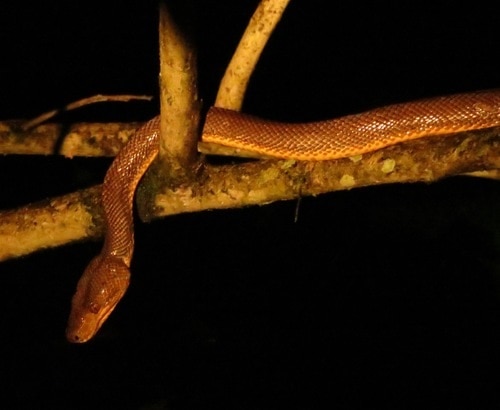
The most common constrictor on Trinidad and Tobago. This is a non-venomous tree dweller which commonly rests at 3-10 metres above ground on a branch, reflecting people’s torch beams in their eyes, even flashing iridescent rainbow colours. Corallus ruschenbergii appear on both the larger island of Trinidad, population 1.27 million, and the smaller Tobago to the north, population 61,000. Local people call them Dormilona, and they have an aggressive temperament both in captivity and the wild. Habitats include forest like Main Ridge Forest Reserve, and swampy forests such as near Nariva swamp and Caroni swamp.
This species also dwells in Venezuela, Costa Rica, and Colombia. Studies reveal that Corallus ruschenbergii (also called the Trinidad tree boa) is larger on these islands than on the mainland. Those on Trinidad ranged 213.3-243.8cm. Likewise, Trinidad versions have a specific colour, lacking vivid patterns, and having a consistent bronze or brown tone.
This species eats reptiles as a youngling, such as Anolis alligator. In adulthood, they graduate to mammals, including Trinidad natives like the Brazilian spiny tree-rat.
| 2 | Tropical flat snake |
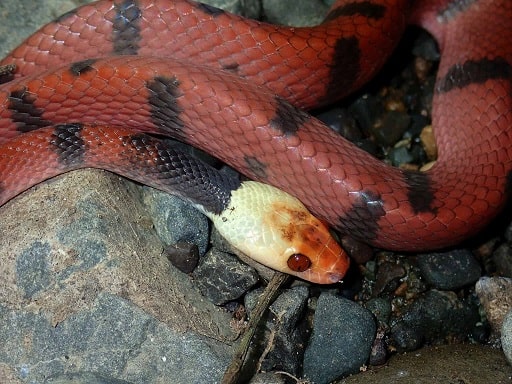
One of a handful of snakes worldwide with blood red eyes. But unlike Europe’s adder, this species cannot kill a human, possessing only a mild venom. Tropical flatsnakes are extremely widespread in South America, covering a swathe of Brazil to Ecuador, Colombia and Costa Rica. Trinidad may have the most dots on the map of all, although they’re not found on Tobago. Siphlophis compressus measures 65-120cm, and is an arboreal snake, spending much of its time on branches, occasionally straying to the ground where they’re spotted on roads. They avoid human-developed zones, preferring untouched forests swarming with native Trinidad wildlife.
Tropical flat snakes prey mainly on reptiles, such as lava lizards (Tropidurus), many-colored bush anoles, and the ubiquitous green iguana. As a nocturnal snake, Siphlophis compressus is thought to snatch lizards while they sleep at night, and reptile eggs have also been observed in their stomach.
Other names include the red-eyed tree snake and mapepire de fe. A bite from Siphlophis compressus will probably cause stinging, a slight swelling, and muscular numbness. Their venom targets scaly reptiles, not workers picking bananas and humans in toiling gardens. The same can’t be said about our next snake…
| 3 | Common lancehead |
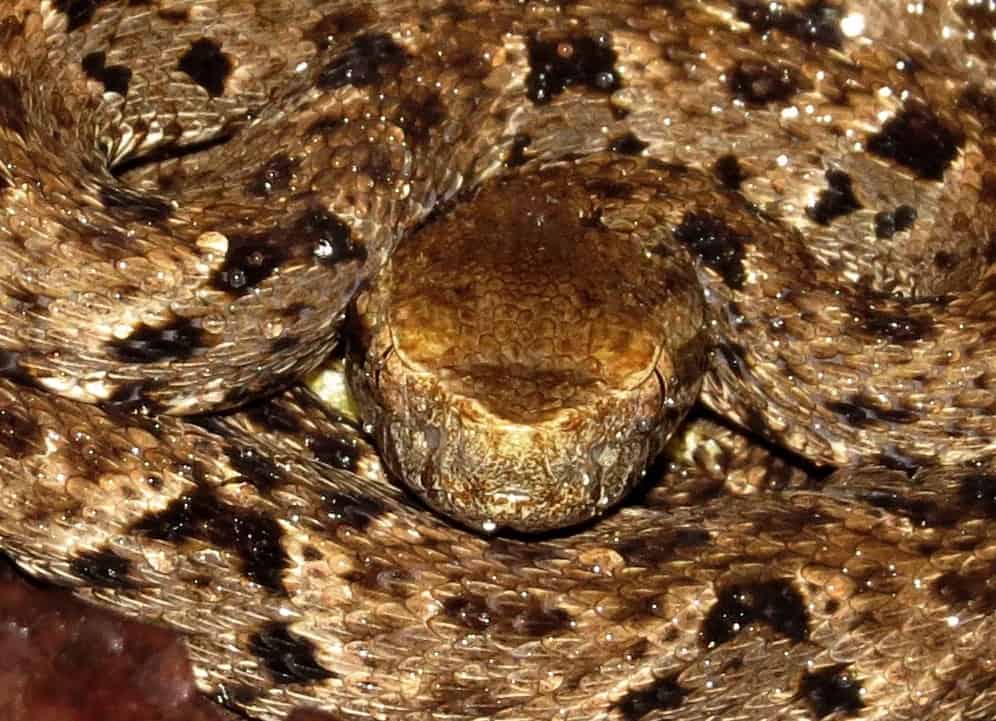
Probably the most common venomous snake in South America, and definitely responsible for the most snakebites. Trinidad and Tobago doesn’t escape the common lancehead’s wrath, which again inflicts the majority of the nation’s venomous snakebites. Bothrops atrox is missing from Tobago, but is abundant on the more populated Trinidad. ID signs include sharp vertical pupils and a bulky head.
A 2009 report documented 9 Bothrops atrox encounters in Trinidad. 1 victim was bitten while pruning plants growing against her house, a 3 year old girl ran into long grass to retrieve her ball and was bitten on the toe, while a middle-aged man was weeding his garden when he dug up a common lancehead which bit him. Those who attended Sangre Grande hospital tended to fare well, as antivenom was stocked there, whereas Mount Hope hospital stocked no antivenom and victims fared worse.
Trinidad locals call this snake mapepire balsain. Common lanceheads can pop up in many places: gardens, forests, banana plantations, hiking trails. This dangerous species averages at 75-125cm, and can exceed 160cm in extreme cases.
| 4 | Long-tailed machete savane |
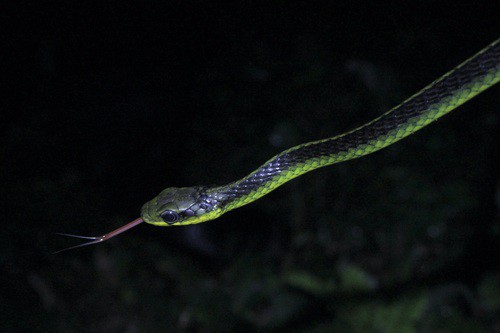
This species lives in Trinidad and Tobago, and the Venezuelan mainland a few dozen miles away. The former is undoubtedly their global hotspot. The long-tailed machete savane (Chironius septentrionalis) moves by day and climbs tree branches with ease, while also being comfortable on the ground. They’re a fast mover which charges down their prey, but can also be found resting in tranquillity on bushes and bamboo. So far, only amphibians have been recorded in its diet, including Leptodactylid southern frogs and Hylid tree frogs. Males reach 1.8 metres, and females 1.9 metres. Large, bulging eyes with round pupils are a signature characteristic to seek.
According to Trinidad locals, this species “bites like a dog”. It comes close, with snappy, vicious bites if disturbed. This is an overcompensation for their non-venomous nature, as they lack even a mild venom. Long-tailed machete savanes also inflate their throat when cornered, in an intimidation display.
Worldwide, this snake is most closely related to Chironius multiventris and Chironius foveatus. Until 2006, it was a subspecies of the former, which is also found in Trinidad.
| 5 | Tobago stream snake |
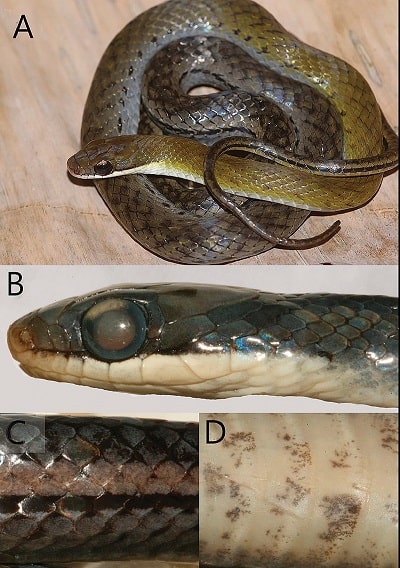
The Erythroplamprus family is collectively dubbed the “false coral snakes” and has 55 members as of 2024, all in Central and South America. The Tobago stream snake was a very recent addition, becoming an official species only in 2019. It lacks the coral-mimicking colours completely, and instead has an olive-grey back, contrasting against a brighter belly with a consistent yellow or red colour.
This is a very rare species. Tobago stream snakes are found mainly in forested ravines bordering Tobago’s main ridge, one of the island’s main geographical features, which reaches heights of 572 metres. Main Ridge Forest Reserve dates back to 1776, and is the oldest forest reserve in the Americas, predating any in the USA. The Tobago stream snake is common within this sanctuary, so while obscure, they’re likely to cling onto survival.
This is the only snake on our list to appear solely on Tobago and not Trinidad. The first batch of Tobago stream snakes ranged from 43.6-53.9cm. Their venom status is unknown, but hidden dangers are possible, as other family members like Erythrolamprus bizona have a highly cytotoxic venom. This is a diurnal, AKA day-faring snake.
| 6 | Boddaert’s tropical racer |
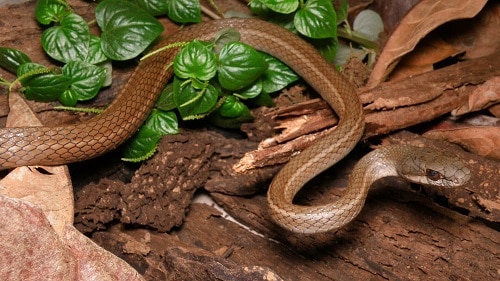
A non-venomous pursuit snake which eats 74% reptiles, 14.3% mammals, and 6.5% frogs and toads. Boddaert’s tropical racers are easily recognisable by a brown back and a light grey belly, with a sharp split between the two. The average length is 105cm, and the record is 180cm. They have round pupils, and are a fast-moving snake which can easily blast off into the undergrowth if cornered.
Boddaert’s tropical racers are especially common in the northern, mountainous regions of Trinidad. They sometimes climb bushes in search of prey, or sleep at night 1-2 metres high on branches, but this is mainly a ground-dwelling snake. You can find them in a mosaic of habitats, including forests and bushy areas with plenty of shade. One of their tricks is coiling into a ball and vibrating their tail furiously. They detach their tail if gripped, sacrificing body parts to escape, but can also spin around and bite viciously.
Mastigodryas boddaerti is definitely found on Trinidad, but Tobago is debateable. There’s certainly a racer on there, but some think it’s a subspecies called M. boddaerti dunni, while others deem this to be a fully independent species.
| 7 | Triangle watersnake |

One of Trinidad’s most aquatic snakes. The triangle watersnake appears in flooded rice fields, swamps, ponds and slow-moving rivers, usually in areas with plenty of shade. Still waters are their favourite of all, rather than raging rapids. Triangle watersnakes encounter humans regularly, as they don’t shy away from swamps directly adjacent to roads. Their eggs are laid in hollows in the banks of water bodies, and their diet consists of fish and especially swamp eels.
Triangle watersnakes are widespread in Brazil and Venezuela as well, but are missing from Tobago. Manzanilla beach lagoon and the Cumuto river are two confirmed hotspots in Trinidad. Rather than dashing around, they move slowly and deliberately.
Triangular watersnakes max out at 78cm, and lay up to 34 eggs per batch. This is a variable snake, with the main morph being a rapidly alternating red and black. Some have jet black faces, while other faces are marbled red-black. Hydrops triangularis is hardly a mass killer, but their venom may be stronger than thought. One bite victim experienced headache, nausea, and even vomiting.
| 8 | Erythrolamprus cobella |
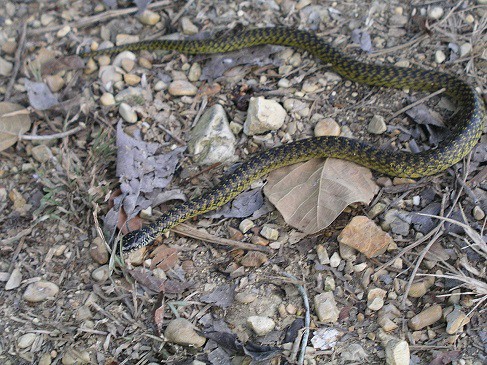
A species which hugs the north coast of South America, covering northern Venezuela, Brazil and Trinidad. Erythrolamprus cobella reaches a maximum of 80cm, and again belongs to the Erythrolamprus false coral snake family, but this time skips Tobago.
Erythrolamprus cobella inhabits watery areas like canals, swamps and rice fields. This is a relatively non-aggressive species. Even if picked up, they stay relatively calm. However, they have a trick they deploy in the presence of other snakes: rearing up and spreading a cobra-like hood. Its diet is poorly researched, but in captivity it happily eats fish. A confirmed wild prey is the turnip-tailed gecko (Thecadactylus) family.
This is a terrestrial snake, very rarely climbing trees. Primary lowland rainforests are their heartlands, usually close to a water source. Instead of keeled, they have smooth scales to touch. While they’re hardly swarming the place, records are plentiful from every corner of Trinidad, except the mountainous north.
Erythrolamprus cobella has medium-sized eyes with round pupils. Originally, they were part of the Liophis genus, until that group was wiped out overnight when every member was transferred to Erythrolamprus, turning it into the 7th largest genus of snakes worldwide.
| 9 | Trinidad upland parrot snake |
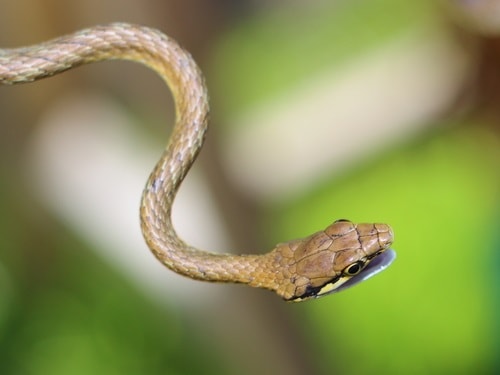
Parrot snakes of the Leptophis family are abundant in Central and South America. This is a branch-dwelling group, which bares their mouth and stares wildly at people when they draw too close. Giant parrot snakes (Leptophis ahaetulla) are the most common, while the Trinidad upland parrot snake (Leptophis stimsoni) is a rarer form which is endemic to its namesake island.
Even in Trinidad, this is a highly rare snake. It was only discovered in 1937, and 50 years passed until the second individual was found, near Cumaca cave in 1987. Leptophis stimsoni appears only in the mountainous north, and being so rare, research is severely lacking.
The original 1937 individual was a male measuring 59.3cm, and like other parrot snakes, it’s a branch and bush dweller, but not exclusively, straying to the ground regularly. They live in primary rainforest with a dense understory, and the first was found near the highly inaccessible Mount Aripo (Trinidad’s highest mountain), which doesn’t even have a trail to its summit. Leptophis stimsoni has a black stripe stretching back from its eyes, and a green-brown body contrasting against a whitish belly.
| 10 | Three-lined ground snake |
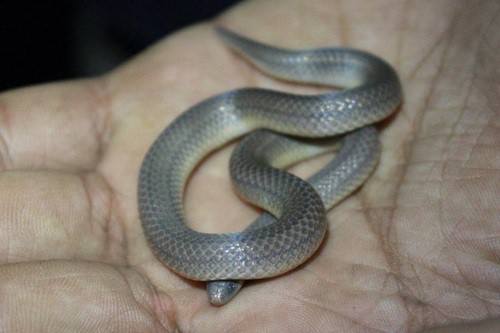
A member of the world’s largest snake genus, Atractus, which boasts 141 members as of 2024. The three-lined ground snake inhabits both Trinidad and Tobago, which are easily its global hotspots. There’s just a few dots outside the nation, such as in Guyana. Atractus trilineatus is grey or brown and was named for three razor thin stripes, one on each flank, and a central stripe down the spine. Their belly is a far brighter yellow.
This is the shortest snake of our list. Atractus trilineatus averages at just 24cm, of which 1.5cm is a sharp tail, used for poking predators in self defence. Atractus trilineatus appears in various habitats, including forest, savannah and plantations. They’re a shy burrower, which aren’t completely blind, but hide in underground soil tunnels when possible. When on the surface, they lurk beneath leaf litter and rotting forest mulch, very similarly to the sharp-tailed snake of the US (whose spiky tail they also share).
This snake is low in the Trinidad food chain, as they’re confirmed predators for freshwater land crabs and Erythrolamprus false coral snakes.
